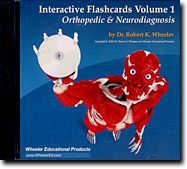|
|
Interactive Flashcards Volume 1: Orthopedic and Neurodiagnosis
CD-ROM Review
by
Steven Lavitan, DC, LAc
| Title: |
Interactive Flashcards Volume 1: Orthopedic and Neurodiagnosis |
| Author: |
Robert K. Wheeler, DC
|
| Part #: |
CCD25
|
 Improvements and new modes of communication are coming fast and furious, but computerized flashcards of neurological and orthopedic tests? This concept may actually be worthwhile for chiropractic students, those taking the national boards or going for diplomat status, or old-timers reviewing neurology and orthopedics.
Improvements and new modes of communication are coming fast and furious, but computerized flashcards of neurological and orthopedic tests? This concept may actually be worthwhile for chiropractic students, those taking the national boards or going for diplomat status, or old-timers reviewing neurology and orthopedics.
The orthopedic section has about 100 cards and the neurological has about 140, with some tests repeated in both. There are discussion cards without a flip side, but most of the flash cards are either photos that are drawn on or computer-generated pictures, and a few are even animated. The flip sides often have comprehensive notes comparing Cipriano, Hoppenfield and Evans, three of the standards in the field.
The program itself is a bit quirky. Instead of clicking on an icon, you're required to put the CD in the drive, and go to "Run" on the start menu. The first time, you have to enter a code that comes with the CD. This procedure is normally used for installing the program, but with the exception of entering the code, it is required every time. Then, you must click the "I Accept the Terms" box to proceed to the actual program; pushing "Enter" does not work. The author had to decide whether to keep it impossible to copy, or to make it more user-friendly. He went for the security features.
The program does not allow you the convenience of going back and forth with other programs while it is running. This review had to be written on another computer while Interactive Flashcards was running. It takes away the advantage of the Windows multi-tasking options. There are no bookmarks, which would allow you to quickly return to previous flashcards, or even keep track of where you are when you restart the program. Additionally, there is no search function. If you want to compare two tests, there is no way to hypertext back and forth quickly.
There are some minor errors in anatomical labeling, and some tests are in the wrong category (a chest expansion measurement is in the neurological cervical section, for instance), but the tests themselves seemed quite accurate.
Active animations are the stars of the program. The Beevor's sign is a classic, and the Trendelburg gait is wonderful. We tend to remember items that are dramatic and interesting. This is the basis for the interactive cards. Many of these tests and/or signs are now indelibly imprinted in my mind.
Most of the cards are photos, and many of these are just too busy, with bookcases in the background, paraphernalia by the adjusting tables, and just too much clutter that takes your eye off the test itself. The animations are best. Hopefully, future editions will take this into consideration, but all and all, it's not a bad first try.
Dr.
Lavitan's
Rating:
 8.5 out
of 10 8.5 out
of 10
|

|








